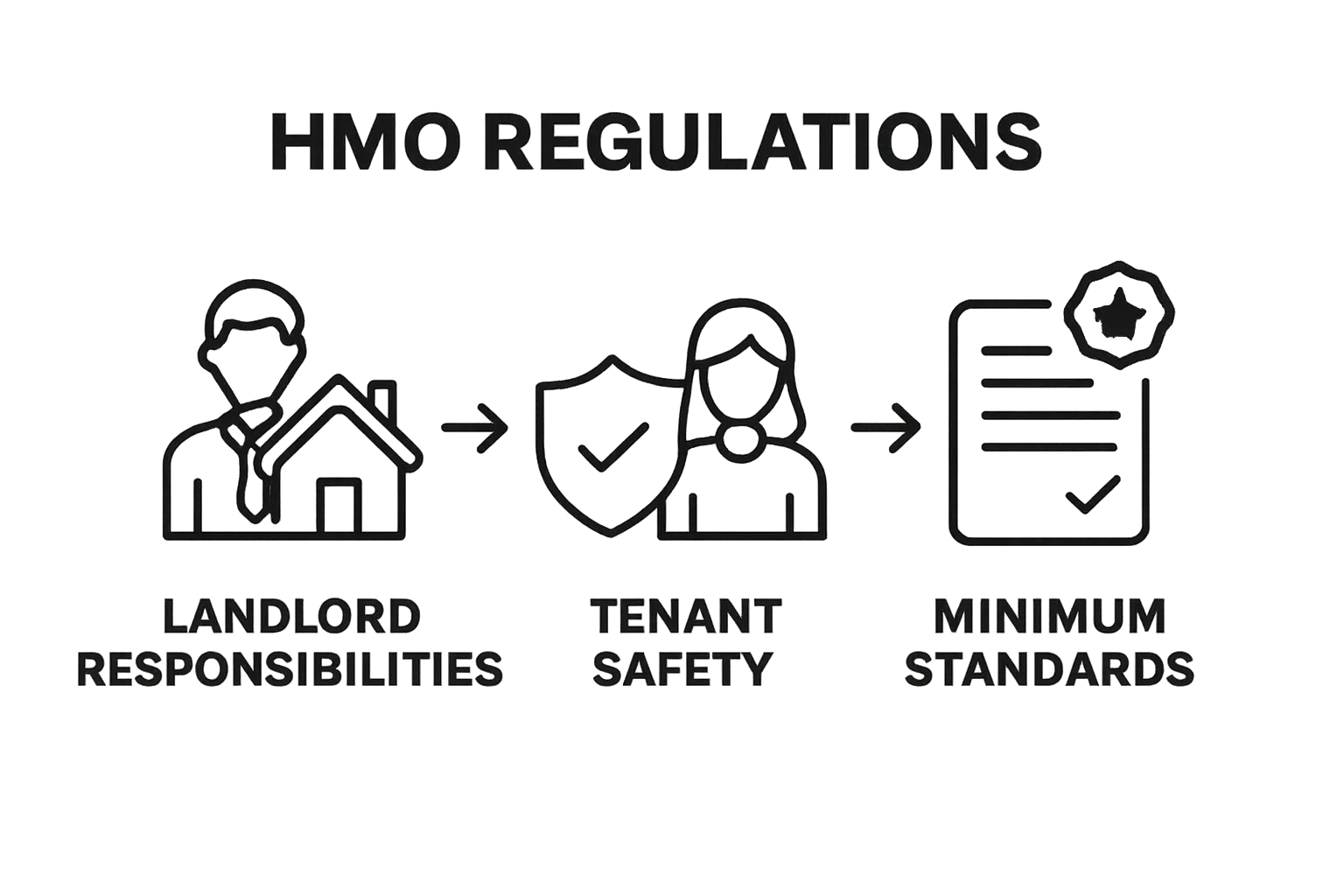HMO regulations are not just legal red tape. More than 500,000 properties in England alone now qualify as Houses in Multiple Occupation, making these rules vital for thousands of households. Yet most people assume they are little more than checklists and fines. The real surprise is how these regulations actually shape safer, fairer and more appealing living spaces for everyone involved.
Quick Summary
| Takeaway | Explanation |
|---|---|
| Understand HMO Definitions | Familiarise yourself with the definition of HMO properties to ensure compliance with zoning laws and requirements. |
| Ensure Tenant Safety Standards | Adhere to strict safety protocols including fire safety, sanitation, and maintenance checks. |
| Obtain Necessary Licenses | Complete the licensing process to legally manage an HMO and avoid penalties or revocation. |
| Maintain Continuous Compliance | Implement ongoing monitoring systems to ensure all properties meet HMO regulatory standards continuously. |
| Protect Tenant Rights | Uphold regulations that safeguard tenant welfare and ensure fair living conditions in shared accommodations. |
Defining HMO Regulations: What They Are
HMO regulations represent a critical legal framework governing properties where multiple unrelated individuals reside together, establishing comprehensive standards to ensure tenant safety, living conditions, and landlord responsibilities. Understanding these regulations is paramount for property investors, landlords, and tenants seeking clarity in the complex landscape of shared residential accommodations.
Core Definition of HMO Properties
A House in Multiple Occupation (HMO) is legally defined as a residential property occupied by three or more tenants who are not from a single household, forming separate living units within the same building. Government housing guidelines specify that these properties require special licensing and management protocols to protect tenant welfare.
Key characteristics of HMO properties include:
- Shared common areas like kitchens, bathrooms, or living spaces
- Multiple tenants from different households
- Typically found in urban areas with high rental demand
- Often involving students, young professionals, or workers
Regulatory Purpose and Tenant Protection
HMO regulations serve multiple critical objectives beyond mere bureaucratic requirements. They establish minimum standards for living conditions, ensuring that properties are safe, habitable, and provide adequate facilities for all residents. These regulations mandate specific requirements around space allocation, amenity provision, fire safety, and overall property maintenance.
For property owners operating HMOs, compliance involves navigating a complex set of legal obligations. This includes obtaining appropriate licences, conducting regular safety inspections, maintaining proper documentation, and ensuring the property meets stringent health and safety standards. Explore our guide on selling HMO property to understand the comprehensive landscape of HMO property management.
Understanding HMO regulations is not just a legal necessity but a fundamental aspect of responsible property management. These rules protect tenant rights, promote safe living environments, and establish clear expectations for both landlords and occupants in shared residential settings.
The Importance of HMO Regulations in Housing
HMO regulations are far more than administrative formalities. They represent a crucial safeguarding mechanism designed to protect the fundamental living standards and safety of tenants in shared accommodation. These regulations address complex social and economic challenges within the rental housing ecosystem.
Protecting Tenant Welfare and Safety
Tenant protection stands at the core of HMO regulations. Housing research from the UK Government demonstrates that shared living environments require stringent oversight to prevent potential risks. These regulations mandate comprehensive safety standards that mitigate potential hazards in multi-occupancy properties.
Key protective elements include:
- Minimum space standards per occupant
- Mandatory fire safety equipment
- Regular property maintenance checks
- Clear emergency evacuation protocols
- Adequate sanitation and hygiene requirements
Economic and Social Implications
HMO regulations extend beyond individual property management, playing a significant role in broader urban housing dynamics. They create structured frameworks that balance tenant rights with property owner responsibilities, ultimately stabilising the rental market. Learn more about HMO property investment to understand the intricate relationship between regulatory compliance and property value.
By establishing clear guidelines, these regulations prevent potential exploitation, ensure fair living conditions, and create transparent mechanisms for conflict resolution. They represent a critical intervention in managing the complex interactions between landlords, tenants, and local housing authorities, ultimately contributing to more sustainable and equitable urban living environments.
How HMO Regulations Impact Property Management
HMO regulations fundamentally transform property management practices, introducing a comprehensive framework of legal requirements that reshape how landlords operate multi-occupancy properties. These regulations demand a strategic, proactive approach to property oversight, moving beyond traditional rental management paradigms.
Operational Compliance Requirements
Parliamentary research on housing regulations highlights the complex operational landscape for HMO property managers. Compliance involves meticulous documentation, systematic safety protocols, and ongoing property maintenance that significantly increases management complexity.
Below is a table summarising the core components and responsibilities related to HMO regulatory compliance for landlords and property managers.
| Key Compliance Requirement | Description |
|---|---|
| HMO Licensing | Must obtain official licence for qualifying properties |
| Regular Safety Inspections | Mandatory checks for fire, gas, and electrical safety |
| Accurate Record Keeping | Maintain detailed and up-to-date tenant and property records |
| Standards of Maintenance | Ensure continuous property upkeep and adherence to minimum standards |
| Risk Assessment | Implement proactive safety and hazard evaluation processes |
| Tenant Welfare Measures | Provide suitable amenities and uphold fair, habitable living conditions |
Key operational responsibilities include:
- Obtaining mandatory HMO licensing
- Conducting regular property safety inspections
- Maintaining detailed tenant records
- Implementing comprehensive risk assessment protocols
- Ensuring continuous property maintenance standards
Financial and Legal Implications
HMO regulations introduce substantial financial considerations for property managers. Non-compliance can result in significant penalties, including substantial fines, potential legal prosecution, and potential licence revocation. Managers must invest in continuous training, robust documentation systems, and proactive property management strategies.
Explore HMO property investment opportunities to understand the intricate balance between regulatory compliance and financial performance. Successful HMO property management requires a nuanced understanding of legal frameworks, tenant rights, and operational efficiency.

Ultimately, HMO regulations represent a sophisticated governance mechanism that ensures responsible property management, prioritising tenant welfare while establishing clear operational standards for landlords and property managers.
Key Elements of HMO Regulations Explained
HMO regulations constitute a sophisticated legal framework designed to establish comprehensive standards for shared residential properties. These regulations represent a multifaceted approach to ensuring tenant safety, property quality, and responsible landlord practices across multi-occupancy housing environments.
Licensing and Mandatory Requirements
Government housing guidelines outline specific criteria for HMO property management. Obtaining an HMO licence is a fundamental requirement for properties housing three or more unrelated tenants, involving a detailed assessment of property suitability and management capabilities.
Critical licensing elements include:
- Comprehensive property safety inspections
- Verification of landlord management competence
- Detailed property layout and occupancy assessments
- Proof of adequate fire safety provisions
- Confirmation of proper amenity standards
Safety and Occupancy Standards
HMO regulations establish rigorous safety and occupancy parameters that go beyond traditional rental property guidelines. These standards address critical aspects of shared living environments, ensuring tenant protection and maintaining minimum living quality benchmarks.
Explore HMO tax implications to understand the financial considerations associated with these comprehensive regulatory requirements. The regulations mandate specific provisions such as minimum room sizes, adequate sanitation facilities, robust fire safety equipment, and clear emergency evacuation protocols.
These regulatory frameworks do more than enforce compliance. They represent a systematic approach to creating safe, sustainable, and equitable shared living spaces, balancing the interests of tenants, property owners, and broader community welfare.

Navigating Compliance with HMO Regulations
Navigating HMO regulations requires a strategic and comprehensive approach that demands meticulous attention to legal requirements, safety standards, and administrative protocols. Property owners must develop a systematic framework for understanding and implementing these complex regulatory mandates.
Application and Licensing Process
Government housing guidelines outline a rigorous process for obtaining HMO licences. Landlords must submit detailed documentation demonstrating their property meets specific safety and management standards. The application process involves comprehensive property assessments and verification of operational capabilities.
Key steps in the licensing process include:
The following table outlines the essential elements assessed during the HMO licensing process, helping clarify the requirements for successful application and ongoing property management.
| Licensing Element | What is Assessed or Required |
|---|---|
| Property Safety Inspection | Evaluation of fire, electrical, and gas safety arrangements |
| Landlord Management Competence | Assessment of landlord’s suitability and management skills |
| Property Layout & Occupancy Review | Confirmation of space standards and maximum permitted occupants |
| Fire Safety Provision | Installation and maintenance of alarms, extinguishers, and evacuation plans |
| Amenity Standards | Verification of toilet, washing, and kitchen facilities |
- Conducting thorough property safety evaluations
- Preparing comprehensive documentation
- Scheduling official property inspections
- Demonstrating compliance with occupancy standards
- Providing evidence of management competence
Ongoing Compliance Management
Successful HMO regulation compliance extends beyond initial licensing. Property managers must establish continuous monitoring systems that ensure sustained adherence to regulatory requirements. This involves regular property assessments, maintaining up-to-date safety certifications, and implementing proactive management strategies.
Learn about professional accounting support to help manage the financial complexities associated with HMO regulatory compliance. Effective compliance requires a holistic approach that integrates legal, safety, and financial considerations.
Ultimately, navigating HMO regulations is not merely about avoiding penalties but creating safe, responsible, and professionally managed shared living environments that protect both tenant welfare and property owner interests.
Take the Stress Out of HMO Compliance with a Smarter Approach
If you are feeling overwhelmed by the complexity of HMO regulations, you are not alone. With demanding licensing rules, strict safety standards and the ever-present risk of penalties, staying compliant can seem difficult for any investor or landlord. Whether you are seeking to protect your tenants, maximise investment returns or avoid legal pitfalls, knowing how to successfully navigate these regulations is crucial.
Now is the time to simplify your journey in the UK HMO market. Visit https://agenthmo.co.uk to discover tailored resources, vetted service providers and current listings designed for HMO owners and investors. From guidance on compliance and financing to direct access to professional management and HMO property investment opportunities, our platform equips you with practical tools and connections. Ready to transform regulation from a burden into an advantage? Explore your options and take action today at AgentHMO.
Frequently Asked Questions
What defines an HMO property?
An HMO (House in Multiple Occupation) property is defined as a residential building occupied by three or more tenants who are not from a single household, sharing common facilities such as kitchens and bathrooms.
Why are HMO regulations important for tenants?
HMO regulations are crucial as they establish minimum safety and living standards for tenant welfare, ensuring that properties are safe, habitable, and legally compliant for residents in shared accommodations.
What are the key compliance requirements for landlords operating HMOs?
Landlords must obtain mandatory HMO licensing, conduct regular safety inspections, maintain accurate tenant records, and ensure that properties meet stringent health and safety standards as outlined in the regulations.
What happens if a landlord fails to comply with HMO regulations?
Failure to comply with HMO regulations can result in significant penalties, including fines, potential legal action, and possible revocation of the HMO licence, impacting the property management and tenant welfare.



